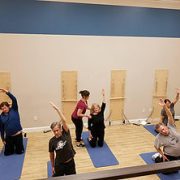Setting Goals for the New Year that you’ll Actually Achieve
2018 is almost here, which means lots of us will be discussing resolutions or considering ways to make the upcoming year our best yet. The start of the new year is a great opportunity to let go of negative energy and bad habits from 2017, while focusing on forming new habits that will help us be our healthiest, happiest selves. Setting detailed goals is a constructive way to approach 2018 that can help you feel more motivated and hopeful about the year as a whole.
The idea of New Year’s resolutions is great, but we all know that few people actually stick to them after a couple weeks. Resolutions are so often left unfulfilled in part because they’re usually pretty general statements that are made without much forethought, intention, or planning. For example, NBC listed the top 5 New Year’s resolutions of 2017 as follows: “get healthy, get organized, live life to the fullest, learn new hobbies, and spend less money.” All worthy ideas, but can you see why people don’t follow through?! There’s WAY too much wiggle room, and nowhere near enough specificity. That’s why oftentimes, setting goals with distinct processes will help you accomplish much more than a run-of-the-mill resolution.
There are two essential factors in goal setting. First, the goal must be attainable. Secondly, you must define concrete steps that you intend to take towards reaching that goal. If your goal is to run the Boston Marathon this April, but you’ve never run more than a mile in your life, you’ll probably just end up feeling discouraged and defeated. A more attainable goal might be to run a local 5k this summer. You can lay out a training plan -i.e., your concrete steps towards the goal- for how far and how frequently you need to run each week, cross training, and any other preparation. That way, when January 2nd rolls around, your goal isn’t to be able to run a 5k- it’s to run half a mile three times this week. Manageable goals are really composed of a bunch of “micro-goals” that are necessary and fulfilling components of the process.

The running example illustrates an individualized and intentional approach to the whole “get healthy” idea. Most of us want to be healthier, but what does that actually look like? One person’s journey to becoming healthy could be totally different from another’s, and the final results might differ drastically as well. Furthermore, “health” as a state of being is not something that can be achieved and forgotten about. Leading a healthy lifestyle is an ongoing responsibility that does not just go away once you reach a desired weight or eat enough vegetables. So instead of resolving to “get healthy,” it would be much more productive to set health related goals that reflect your individual experience. These goals can be made in conjunction with a health professional such as a physical therapist, especially if they relate to mobility, strength, and physical activity. Many of us have intended to “exercise more,” but those two words rarely yield results. A more effective goal might be to enroll in a Pilates class, take a half hour walk outside five days a week, drink the recommended 64 ounces of water each day, or to do ten minutes of stretching every morning after getting out of bed. If the steps towards your goal can be tracked, scheduled,or measured,you’ll know when you’re making progress.
Need help setting healthy goals for the new year? We can help! Get in touch anytime via our website or Facebook. Be sure to follow us on Instagram as well @cjphysicaltherapy. You can also see our Pilates offerings here! Happy New Year!









